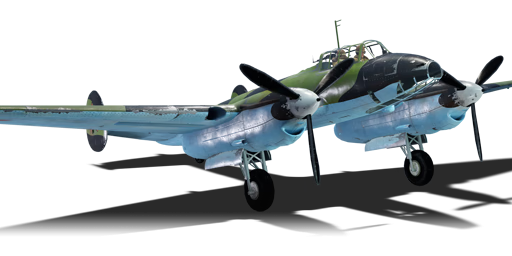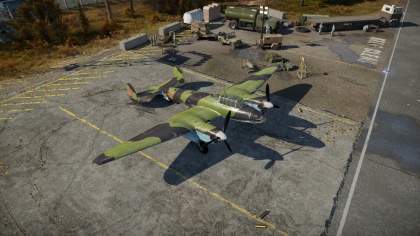Difference between revisions of "Pe-2-31"
grazandrik (talk | contribs) |
Inceptor57 (talk | contribs) m (→Pros and cons) |
||
| Line 210: | Line 210: | ||
=== Pros and cons === | === Pros and cons === | ||
| − | <!-- | + | <!--Summarise and briefly evaluate the vehicle regarding its characteristics and combat effectiveness. Mark its pros and cons in the bulleted list. Do not use more than 6 points for each of the characteristics. Avoid using categorical definitions such as "bad", "good" and the like - they have a substitution in the form of softer "inadequate", "effective".--> |
'''Pros:''' | '''Pros:''' | ||
| Line 217: | Line 217: | ||
* Great rate of climb | * Great rate of climb | ||
* Maneuverable | * Maneuverable | ||
| − | |||
| − | |||
'''Cons:''' | '''Cons:''' | ||
| − | * Low | + | * Low bomb Load |
| − | + | * Large silhouette | |
| − | * Large | ||
| − | |||
| − | |||
== History == | == History == | ||
Revision as of 07:32, 14 May 2019
Contents
| This page is about the Russian bomber Pe-2-31. For other uses, see Pe-2 (Family). |
Description
The Pe-2-31 Peshka is a Rank II Russian bomber
with a battle rating of 3.3 (AB/RB) and 3.7 (SB). It was introduced into the game sometime prior to Update 1.27. For French, German, Italian, Castellano, and Japanese, this aircraft is known as Pe-2-21 in the localisation files, instead of Pe-2-31. There is no difference between them.
General info
Flight Performance
| Characteristics | |||||||
|---|---|---|---|---|---|---|---|
| Stock | |||||||
| Max Speed (km/h at ?,000 m) |
Max altitude (meters) |
Turn time (seconds) |
Rate of climb (meters/second) |
Take-off run (meters) | |||
| AB | RB | AB | RB | AB | RB | ||
| ? | ? | 8400 | ??.? | ??.? | ??.? | ??.? | ??? |
| Upgraded | |||||||
| Max Speed (km/h at ?,000 m) |
Max altitude (meters) | Turn time (seconds) | Rate of climb (meters/second) |
Take-off run (meters) | |||
| AB | RB | AB | RB | AB | RB | ||
| ? | ? | 8400 | ??.? | ??.? | ??.? | ??.? | ??? |
Details
| Features | ||||
|---|---|---|---|---|
| Combat flap | Take-off flap | Landing flap | Air brakes | Arrestor gear |
| X | X | X | X | X |
| Limits | ||||
|---|---|---|---|---|
| Wing-break speed (km/h) |
Gear limit (km/h) |
Combat flap (km/h) |
Max Static G | |
| + | - | |||
| 740 | 450 | ??? | ~?? | ~? |
| Optimal velocities | |||
|---|---|---|---|
| Ailerons (km/h) |
Rudder (km/h) |
Elevators (km/h) |
Radiator (km/h) |
| < ??? | < ??? | < ??? | > ??? |
| Compressor (RB/SB) | ||
|---|---|---|
| Setting 1 | ||
| Optimal altitude | 100% Engine power | WEP Engine power |
| ?,??? m | ??? hp | ?,??? hp |
Survivability and armour
- No armour plating
- No armour glazing
- Critical components located at the front of aircraft (fuel, pilot, engine, controls)
- More fuel tanks located in wings near the fuselage
Armaments
Offensive armament
Main article: Bombs-->
Usage in the battles
Manual Engine Control
| MEC elements | ||||||
|---|---|---|---|---|---|---|
| Mixer | Pitch | Radiator | Supercharger | Turbocharger | ||
| Oil | Water | Type | ||||
| Controllable | Not controllable | Not controllable | Not controllable | Separate | Not controllable | Not controllable |
Modules
| Tier | Flight performance | Survivability | Weaponry | ||
|---|---|---|---|---|---|
| I | Fuselage Repair | Radiator | |||
| II | Compressor | Airframe | |||
| III | Wings Repair | Engine | |||
| IV | Engine Injection | Cover | |||
Pros and cons
Pros:
- Light weight
- Great rate of climb
- Maneuverable
Cons:
- Low bomb Load
- Large silhouette
History
Describe the history of the creation and combat usage of the aircraft in more detail than in the introduction. If the historical reference turns out to be too big, take it to a separate article, taking a link to an article about the vehicle and adding a block "/ historical reference" (example: https://wiki.warthunder.com/Name-vehicles/historical reference) and add a link to it here using the main template. Be sure to include links to sources at the end of the article.
In-game description
"Since the Pe-2's mass production had begun, its defensive armament was recognized by the military as weak for a modern bomber. Beginning with series 13 (launched in April to May of 1941), the ShKAS hatch mount was replaced with a VUB-2 turret with a 12.7mm BT machine gun and a magazine capacity of 200 rounds. The starboard ShKAS machine gun mounted to port forward was replaced with a 12.7mm BK machine gun with 150 rounds. Also, the magazine capacity of the port ShKAS was decreased to 450 rounds.
By June 22, 1941, when Germany invaded the USSR, factories had managed to produce 490 new dive bombers. Subsequent upgrades of the Pe-2 were then made based on combat experience.
Series 22 saw the installation of M-105RA engines with floatless carburettors, which improved the aircraft's behavior when diving. Beginning with series 23, an extra ShKAS machine gun with 225 rounds was installed in the radio operator/gunner's cockpit. It was designed to fire from side ball mounts and through the upper fuselage hatch. The area of the navigator's and the radio operator/gunner's protective armor was increased, and the robustness of the fuel system was improved. The aircraft was equipped with an inert gas filling system, and duralumin tanks were replaced with fiber ones, which were more effective at dealing with bullets. By series 32, the aircraft could be fitted with guide rails to hold 10 RS-132 unguided rockets under the wings. Some Pe-2s were equipped with RO-82 launchers to fire RS-82 unguided rockets backwards, to defend against any fighters attacking from the aircraft's lower rear. Since September 1941, the Pe-2's bomb load was upgraded by adding KMB-Pe-2 bomblet clusters, which enabled the efficient bombing of soft area-type targets.
A total of 1,671 dive bombers were manufactured by four mass production factories during 1941. The new plane served on all front lines from the Barents Sea to the Black Sea. The Pe-2s were received not only by regiments of the Air Force of the Workers’ and Peasants’ Red Army but also by aviation units of the Northern, Baltic, and Black Sea Fleets.
From February 1942 (series 64) on, the side ball mounts were replaced with pivot mounts and the turret's sighting angle was increased. Series 80 saw yet another defensive upgrade: the navigator's and the radio operator/gunner's positions were given upgraded armor.
On 12 January 1942, chief designer V. M. Petlyakov died in an air crash while flying in a Pe-2. His position was filled by his deputy, A. M. Izakson, who was later replaced by another of Petlyakov's colleagues, A. I. Putilov."
Media
An excellent addition to the article will be video guides, as well as screenshots from the game and photos.
Read also
Links to the articles on the War Thunder Wiki that you think will be useful for the reader, for example,
- reference to the series of the aircraft;
- links to approximate analogues of other nations and research trees.
Sources
Paste links to sources and external resources, such as:
- topic on the official game forum;
- page on aircraft encyclopedia;
- other literature.
| USSR bombers | |
|---|---|
| SB and Ar | SB 2M-100 · SB 2M-103 · SB 2M-103 MV-3 · SB 2M-103U · SB 2M-103U MV-3 · SB 2M-105 · Ar-2 |
| Yer-2 (petrol) | Yer-2 (M-105) · Yer-2 (M-105) TAT · Yer-2 (M-105R) TAT · Yer-2 (M-105R) LU |
| Yer-2 (diesel) | Yer-2 (ACh-30B) (e) · Yer-2 (ACh-30B) (l) |
| Tu | Tu-2 · Tu-2S · Tu-2S-44 · Tu-2S-59 · Tu-4 |
| Pe | Pe-2-1 · Pe-2-31 · Pe-2-83 · Pe-2-110 · Pe-2-205 · Pe-2-359 · Pe-8 |
| IL | DB-3B · IL-4 |
| Po | Po-2 · Po-2M |
| Other | MBR-2-M-34 · TB-3M-17-32 · Yak-4 · Be-6 |
| Lend-Lease | ▂PBY-5A Catalina · ▂Hampden TB Mk I · ▂A-20G-30 · ▂B-25J-30 |





